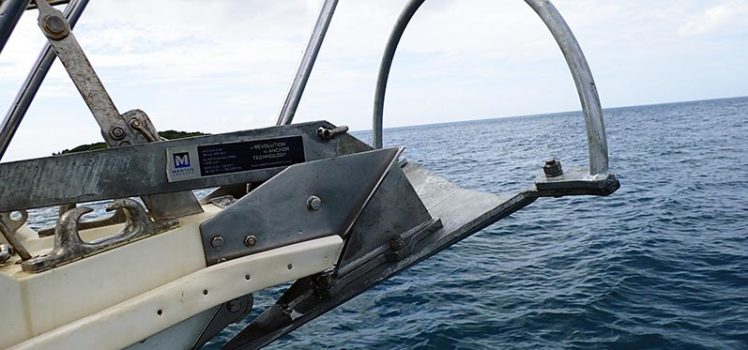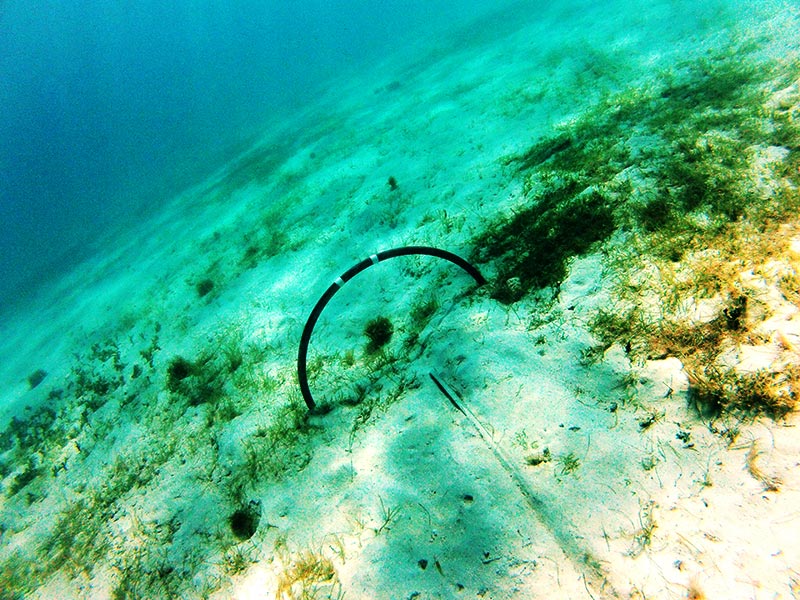While not typical, this time we actually went looking for grass

The topic of anchors and anchoring is one that always inspires emotion in cruisers, especially if it devolves into the “my anchor is better than yours” argument. A statement I have heard more than once during these oftentimes-heated discussions is something along the lines of, “My anchor catches on the first try, every time.” Well, coming from someone who has used only heavy, next-generation anchors on each of the 3 boats that I have skippered, I have to call bullshit on that. People who make that statement are either:
- never leaving the dock
- only anchoring in a sandbox
- unaware of what a properly set anchor looks/feels like
- lying
Take yesterday for example. The previous two days we had Frost affixed to one of the marina’s mooring balls to attend to some projects, which was good considering all the west-wind drama. When we cast off just before noon, we returned to the “parking lot,” – what we call the busy anchorage in Le Marin – to anchor close to the spot we had been the days prior. The water is of quite a variable depth in that area, dropping from 20 feet to 40 feet in just a short distance, and it’s also dark enough that one can’t typically see the bottom. It took us two attempts to get our anchor to grab there, the first time we could feel it skating across the bottom.
If it’s not obvious, you can normally feel if the anchor is dragging over a rocky bottom by placing your hand or foot on the anchor chain. Obviously, be careful.
Even though we managed to get it securely set on the second try, after relocating the boat one hundred feet or so to the north, we decided that we’d rather move back out to St. Anne for a change of scenery, and to reconnect with some friends who were due to sail in later that day. When we arrived there, in an anchorage that, on the surface, seems about as easy a place to anchor as is possible, it still took us two tries to get the anchor to hold! Here is why:
Most people know that anchors hold well in sand. Unfortunately, from the water’s surface, small bits of broken coral looks pretty much the same as sand: they’re often both bright yellow (with the sun shining down on them). The St. Anne anchorage has many such places, and an anchor, even our oversized Mantus which I think is one of the best out there, if not the best, can’t bury itself when there is nothing to dig in to (ie. rock).
The last time we arrived in St. Anne it took us three attempts to get our anchor set in a spot where we were comfortable. The first two times, when we dropped the anchor in patches of “sand,” we could feel it bouncing across the rubble. The third time we inadvertently dropped it into a grassy area, and it dug in perfectly.

An older photo showing a well-buried Mantus. This was not taken yesterday.
So, based upon our past experiences, and since we were unsuccessful in our initial attempt to get the anchor to bury, we decided to try something different. Rather than look for a sandy spot, we deliberately sought out a patch of grass. My thinking was that if there is grass growing there, the bottom couldn’t be rock. Guess what? It worked! Would I suggest doing that all the time? No, not at all, but doing the same thing over and over again while expecting a different result isn’t so smart either.



Now that is a valuable tip! We never made it into Le Marin or St. Ann. Care to publish a preferred anchor spot lat long in case we ever get the chance? Thx.
Hi Kirk
Thanks! I don’t think the lat/long would help very much. The St. Anne anchorage is huge. You can literally anchor a mile wide and a mile out from shore. It’s all pretty shallow so you can see the bottom in good light. We normally anchor near the back of the pack as we’re anti-social. 🙂
As for Le Marin, it’s so crowded that you need to look around for a spot. We have been anchoring close (but not too close) to the black and red isolated danger mark on the east side of the channel.
I feel that, compared to older-generation anchors, the next-generation anchors are an improvement by an order of magnitude when considering 1st-time setting of the anchor. While it doesn’t happen every single time, without fail, in all bottom conditions these newer anchors are much more likely to set -and more importantly re-set when they pull out after a substantial wind shift.
When using a proper scope of 7-1 or more this gives an added degree of confidence in one’s ground tackle.
Using something like a Danforth or even an older design plow is something I’d only really trust as a supplemental anchor after diving on it to visually inspect that it was properly set, and ensuring that it can’t be pulled out by the boat moving after a wind shift using various techniques utilizing multiple anchors. Bahamian moor, bow & stern, tandem, etc.
I agree that if the bottom is something other than rubble, they will set, and normally reset. That’s why I was confident the grass wouldn’t affect it. Of course, when possible, as it is here, we always visually inspect the anchor’s position by diving on it, and watch it set while backing down incrementally.
The first time I dropped an anchor in the BVI’s (Cooper Island) I had a similar experience and could hardly believe it. After years and years of successful sand anchoring I placed my 35# CQR right in the middle of a nice spot of pure white sand.
However when I backed down it seemed to slip and then really took hold. BUT, I soon realized that what had happened was that the anchor had failed to dig in because the “sand” was only about an inch or two deep sitting over a solid base of rock or limestone. So what occurred was that the anchor slid across the “sand” about 30 feet before burying itself within a huge coral boulder.
Worse yet, it wasn’t coming out of that coral rock no matter how carefully I tried to maneuver the boat to obtain a reversing pull.
Fortunately it was shallow enough (~ 30 feet) that I was able to free dive down and extract the anchor from the coral by hand while my wife kept tension off the chain. BTW, this didn’t damage any of the hard coral what-so-ever, for which I was grateful.
Ever since that time I’ve known that “sand” isn’t always what it appears to be!
Exactly. We know of several places where the “sand” is only an inch or two deep. The area we’re in now is also full of coral “boulders,” just large enough to hook an anchor to make someone think that they are secure. Of course, if the wind shifts, and it dislodges, they find that they’re not.
I’ve been doing a LOT of testing for an up-coming book on anchoring, and I have learned that thin sand and rock are the ONLY place were two anchors in tandem make sense, better than doubling holding power. But there are some rules:
* The rode MUST stay on the bottom. That means 15-20:1 scope. Not cheating or the lead anchor will lift.
* The lead anchor MUST have an attachment eye either near the bottom of the shank (Rocna) or add one to the back of the fluke. I added an eye to my Manson Supreme. If you do not have such an eye, don’t try it (the tripping eye will trip the lead anchor, no matter what the books say).
* The rode between them must be 20-40 feet high strength chain.
* You will need a deployment/recovery line ~ 10 feet longer than the secondary rode. This is tied to the main rode, just before the main anchor.
By the way this does NOT work on sand or mud, no matter what Rocna says. The lead anchor will roll out due to normal yawing every time. At least that is what happened for me, many dozens of times. Don’t do it.
As Mike will agree, one big anchor is better 98% of the time.
And yeah, I like the idea of hunting for weeds. I’ve done that a few places.
Looking forward to your book!
You could of looked in the Hudson River if you wanted a weedy spot . 😉
We found some.
http://www.zerotocruising.com/pics-can-not-possibly-do-this-justice
There’s a guy on the Sailing Anarchy Cruising Forum (Steve on s/v Panope) that has eclipsed all of the magazine anchor tests by borrowing, begging and trying most every type of anchor in various holding conditions, over the course of what seems to be thousands of man-hours on his own. His efforts include data, videos, and excellent commentary:
http://forums.sailinganarchy.com/index.php?showtopic=169269&hl=anchor
No sponsorship involved; he’s just a geek. My kind. 😉
Mike
Without checking, I’m going to guess that one of these was the overall winner:
Mantus
Rocna
Manson Supreme
Spade
I have always loved this quote, “doing the same thing over and over again while expecting a different result isn’t so smart either”. It’s amazing how many people will continue doing the same thing over and over and over again. This goes along with, “You can’t fix stupid”…
Resistance to change is well-ingrained in some people.
I remember pulling this one guy off the sand sand bar 3 times in a row.
“But that’s where the markers say the Chanel is!”
It only took me one time. 🙂